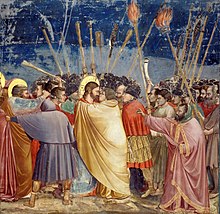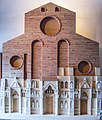Duecento
Duecento (
The period built on the so-called Renaissance of the 12th century, and movements originating elsewhere, such as the Gothic architecture of France. Most of the innovation in both the visual arts and literature was concentrated in the second half of the century, after about 1250, when major new directions opened up in both painting and sculpture, mostly in northern Italy, and the Dolce Stil Novo (Sweet New Style) emerged in poetry.
Characteristics
In the 13th century, much of Europe experienced strong economic growth. The trade routes of the Italian states linked with those of established Mediterranean ports and eventually the Hanseatic League of the Baltic and northern regions of Europe to create a network economy in Europe for the first time since the 4th century. The city-states of Italy expanded greatly during this period and grew in power.
During this period, the modern commercial infrastructure developed, with the creation in Italy of the
Many argue that the ideas that characterized the Renaissance had their origin in late 13th century Florence, in particular with the writings of
The Duecento was followed by the beginning of the Italian Renaissance during the Trecento.
Literature
The thirteenth-century Italian literary revolution helped set the stage for the Renaissance. During this century, the standard modern Italian language began to be fixed, mainly as a literary language. Previously each region used its own language, as many continue to do, at least in the common spoken language. The standard modern Italian language began in poetic and literary writings of Tuscan and Sicilian writers of the 12th century, and the grammar and core lexicon are basically unchanged from those used in Florence in the 13th century.[5]
It was only in the 13th century that Italian authors began writing in their native language rather than Latin, French, or Provençal. The 1250s saw a major change in Italian poetry as the Dolce Stil Novo (Sweet New Style, which emphasized Platonic rather than courtly love) came into its own, pioneered by poets like Guittone d'Arezzo and Guido Guinizelli. Especially in poetry, major changes in Italian literature had been taking place decades before the Renaissance truly began. An increasing number of works began to be written in the Italian language in addition to the flood of Latin and Greek texts that constituted the mainstream of the Italian Renaissance.
Written works expanded beyond works of
Christianity remained a major influence for artists and authors, with the classics coming into their own as a second primary influence.
Literature in Latin continued to be written, with Saint Thomas Aquinas's Summa Theologica a massive and unfinished summary and exploration of the theology of the medieval church, which has continued to be influential.
Painting
The art of the region of Tuscany (and northern Italy) in the second half of the 13th century was dominated by two masters: Cimabue of Florence and Duccio of Siena. Their commissions were mostly religious paintings, several of them being very large altarpieces showing the Madonna and Child. These two painters, with their contemporaries, Guido of Siena, Coppo di Marcovaldo and the mysterious painter upon whose style the school may have originated, the so-called Master of St Bernardino, all worked in a manner that was highly formalised and dependent upon the ancient tradition of icon painting.[7] Cimabue and Duccio both took steps in the direction of greater naturalism, as did their contemporary, Pietro Cavallini of Rome.

Sculpture


The Pisa pulpit was probably originally polychrome, which had been usual for Italian Romanesque sculpture. It also seems to have largely carved by Nicola himself.[13] The Arca di San Domenico, a large free-standing tomb monument for Saint Dominic in Bologna, was begun in 1264, though work by many other hands continued for centuries. Nicola and his team completed the reliefs around the sarcophagus.

Nicola's son Giovanni Pisano took over his father's workshop in the 1280s, and was much more receptive to Gothic style than his father. His Pulpit of Sant' Andrea, Pistoia is similar in form to his father's ones in Pisa and Siena, but shows a different style.[14] Over the next century Gothic and classical influences were found together in many large works, sometimes in contention.[15]
The other leading sculptor of the period was Arnolfo di Cambio (c. 1240 – 1300/1310), who was also an architect. Born in Tuscany, he also trained with Nicola Pisano, and was his chief assistant on the Siena Cathedral Pulpit. After he began working as an independent master he spent two periods in Rome, bringing the new Tuscan style there. He worked on a number of papal tombs.
Architecture
The Dominican and Franciscan orders of
The most important buildings include
This century saw the construction of numerous Gothic buildings for the Mendicant Orders. The most important ones include:
- Basilica of San Francesco of Assisi(1228–1253)
- Church of Santa Maria della Spina, Pisa (1230)
- Basilica of Sant'Antonio of Padua
- Church of San Francesco, Bologna (1236–1263)
- Church of Santa Maria Novella, Florence
Also notable is the civil and military construction program promoted by Emperor and King of Sicily
- Castel del Monte, in Apulia
- Syracuse, Sicily
- City Gate of Capua, an imperial Romanesque evocation of a Roman triumphal arch, in Capua. This is now destroyed though some of the sculpture is in museums.
In this period some cathedrals were also constructed or finished, such as Siena Cathedral.
Gallery
-
Vita di San Francesco, of Bonaventura Berlinghieri, 1235
-
Cross of Santa Croce, of Cimabue
-
Model of the facade of Florence Cathedral, by Arnolfo di Cambio
-
Giotto: St. Francis' Sermon to the Birds
-
Basilica of San Francesco of Assisi: Nave of the upper basilica (built 1228–1253)
-
Perugia's Fontana Maggiore, by Pisano
-
Guido da Siena's "Flight into Egypt"
See also
- Trecento – the 14th century in Italian culture
- Quattrocento – the 15th century in Italian culture
- Cinquecento – the 16th century in Italian culture
- Seicento – the 17th century in Italian culture
- Settecento – the 18th century in Italian culture
- Ottocento – the 19th century in Italian culture
- Novecento - the 20th century in Italian culture
- History of Italy
Notes
- ^ "duecento". Collins English Dictionary. HarperCollins. Retrieved 1 June 2019.
- ^ The Oxford Dictionary of Art (3rd ed.), s.v. "Quattrocento".
- ISBN 9780691162409.
- ^ Knight, Kevin (2017). "Dante and his time". Catholic Encyclopedia. Retrieved 9 October 2018 – via New Advent.
- ^ Coletti, Vittorio (2011). "Storia della lingua". Istituto della Enciclopedia italiana. Retrieved 10 October 2015.
L'italiano di oggi ha ancora in gran parte la stessa grammatica e usa ancora lo stesso lessico del fiorentino letterario del Trecento.
- JSTOR 478819.
- OCLC 5976552.
- Lives of the Artists.
- Italian Renaissance painting, development of themes
- OCLC 518807.
- ^ Clark, 219–221, 236–237; Avery, 181; Seymour, 8
- ^ Hartt, 51–58; Avery, 11–18; White, 74–91; Osborne, 876–877
- ^ White, 81-83
- ^ White, 113–142; Hartt, 55–58
- ^ White, 591–614
Bibliography
- Burke, Peter. The Italian Renaissance: Culture and Society in Italy Princeton University Press. Princeton, 1999.
- Shaw, Prue. Reading Dante: From Here to Eternity. Liveright Publishing. New York, 2014 ISBN 978-1-63149-006-4.
- Nolthenius, Helene. ‘’ Duecento: The Late Middle Ages in Italy’’. McGraw-Hill. New York, 1968.
- ISBN 0300055854









